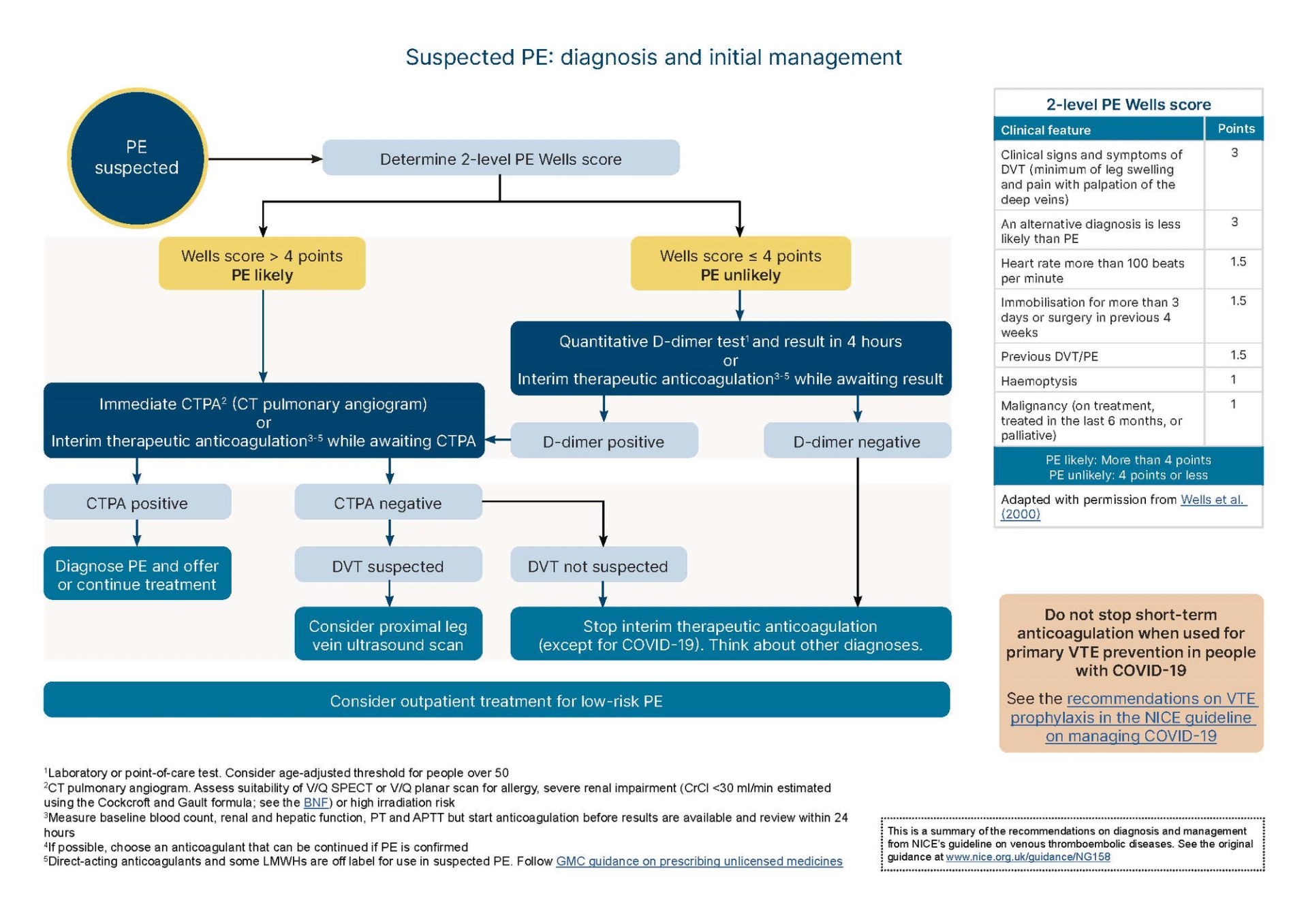PE (pulmonary embolism)
Pulmonary embolus (PE) occurs when a clot from a vein, originating in the venous sinuses of the calf or the femoral vein or the pelvis, detaches and becomes lodged in the pulmonary arterial tree (1).
Occasionally the right side of the heart is a source of a pulmonary embolus.
Deep vein thrombosis (DVT) is the formation of blood clots in deep veins of the legs (1). In a majority of patients, PE is a consequence of DVT (2)
- when sensitive diagnostic methods were used, DVT was detected in around 70% of patients with PE (2)
- clinically important PEs originate from proximal DVT of the leg e.g. - popliteal, femoral or iliac veins (3)
Venous thromboembolism (VTE) is the term used to describe a thrombus in a vein which may detach from the site of origin and travel through blood to a distant site, a phenomenon called embolism (1). PE and DVT represent different clinical manifestations of VTE (2).
An estimated 12-36% of patients with PE are misdiagnosed during initial evaluation in emergency departments or primary care clinic (4)
Non thrombotic pulmonary emboli are rare. Causes include:
- septic emboli
- fat emboli
- amniotic fluid
- venous air embolism
- intravascular foreign bodies
- tumour emboli (2)

Computed tomography pulmonary angiogram (CTPA) scan
- most common diagnostic imaging modality for PE
- V/Q SPECT (ventilation-perfusion single photon emission CT) is a scintigraphic modality that captures three dimensional images and offers equal diagnostic accuracy as CTPA while delivering a lower absorbed dose of radiation (4,5)
References:
- NICE. Venous thromboembolism in over 16s: reducing the risk of hospital-acquired deep vein thrombosis or pulmonary embolism. NICE guideline NG89. Published March 2018, last updated August 2019
- Meyer G et al. 2019 ESC Guidelines for the diagnosis and management of acute pulmonary embolism developed in collaboration with the European Respiratory Society (ERS): The Task Force for the diagnosis and management of acute pulmonary embolism of the European Society of Cardiology (ESC). European Heart Journal. Volume 41. Issue 421 January 2020.
- Ramzi DW, Leeper KV. DVT and pulmonary embolism: Part I. Diagnosis. Am Fam Physician. 2004;69(12):2829-36.
- NICE. Venous thromboembolic diseases: diagnosis, management and thrombophilia testing. NICE guideline NG158. Published March 2020, last updated August 2023
- Maughan B C, Jarman A F, Redmond A, Geersing G, Kline J A. Pulmonary embolism. BMJ 2024; 384 :e071662 doi:10.1136/bmj-2022-071662
Related pages
- Grades of pulmonary embolus
- Risk factors and associated increased risk for development of venous thromboembolism in surgical patients
- Epidemiology
- Pathophysiology
- Clinical features
- Assessment of clinical probability of pulmonary embolism (PE)
- Severity of pulmonary embolism (PE)
- Recommendations on the diagnostic investigations to be employed in suspected PE
- Investigations
- Diagnosis of pulmonary embolism
- Treatment of pulmonary embolism
- Risk of recurrence of thromboembolism
- Thrombophilia screen or screening
- Reducing the risk of venous thromboembolism (VTE) and air travel
- General advice regarding reducing the risk of venous thromboembolism in surgical patients
- Cancer and venous thromboembolism (VTE)
- Anticoagulation for deep venous thrombosis (DVT)
- Venous thromboembolism
- Pulmonary embolism rule-out criteria (the PERC rule)
Create an account to add page annotations
Annotations allow you to add information to this page that would be handy to have on hand during a consultation. E.g. a website or number. This information will always show when you visit this page.